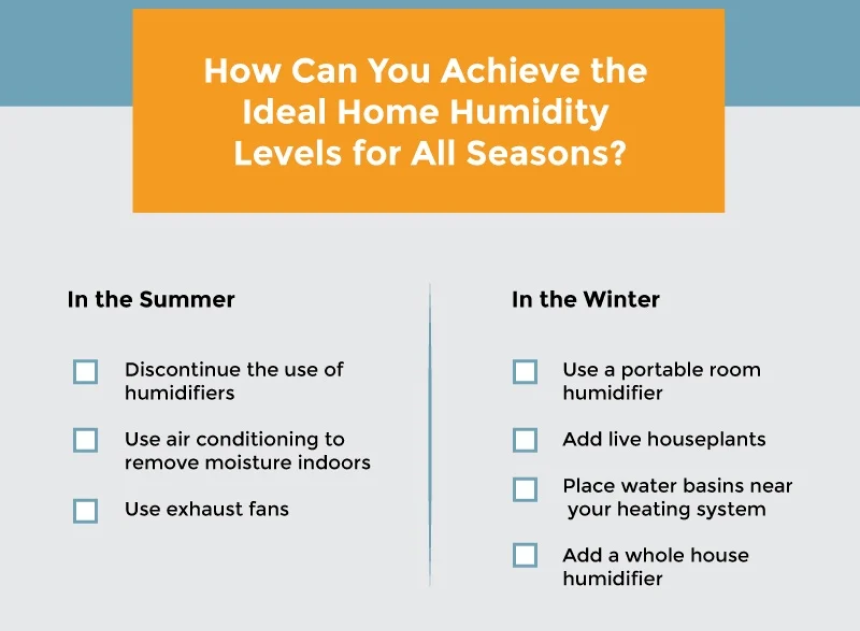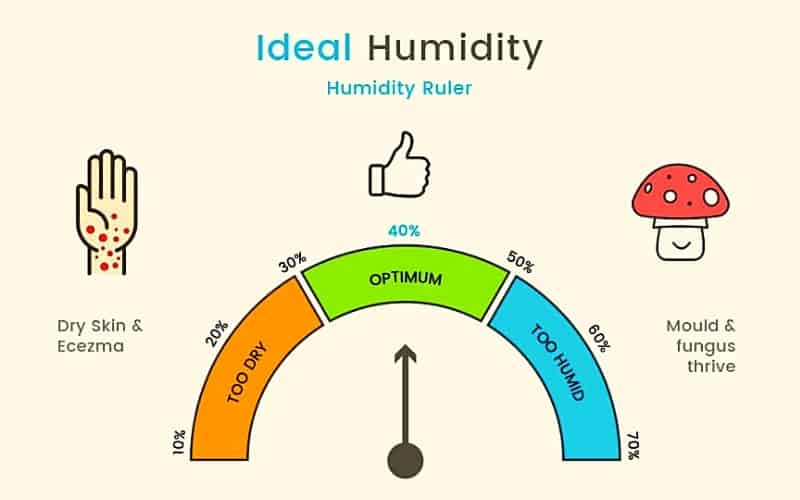What Should The Humidity Be In The House

Frequently Asked Questions About Ideal Home Humidity
Maintaining the right humidity level in your home is crucial for your comfort, health, and the preservation of your property. Too much or too little moisture can lead to a variety of problems. This FAQ aims to answer your most pressing questions about ideal home humidity.
Q1: What is the ideal humidity level for a house?
The generally accepted ideal humidity level for a house is between 30% and 50%. This range provides a comfortable and healthy environment for most people. During the winter, it's often recommended to keep the humidity closer to the 30-40% range to prevent condensation on windows and other cold surfaces.
It's important to note that these are just guidelines. Personal preference and specific circumstances, such as allergies or pre-existing health conditions, may influence your ideal humidity level. Monitoring humidity levels with a hygrometer and adjusting accordingly is always recommended.
Q2: How can I measure the humidity in my house?
You can measure the humidity in your house using a device called a hygrometer or humidity meter. These devices are readily available at most hardware stores, online retailers, and even some department stores. They come in both analog and digital versions.
For accurate readings, place the hygrometer in a central location away from direct sunlight, vents, and exterior walls. Multiple hygrometers in different areas of the house can give you a more comprehensive understanding of the humidity levels throughout your home.
Many modern thermostats and smart home devices also include built-in humidity sensors, making it even easier to monitor humidity levels.
Q3: What problems can arise from having too much humidity (high humidity)?
High humidity, generally considered above 60%, can lead to a host of problems, affecting both your health and your home's structure. Here are some common issues associated with excessive humidity:
- Mold and Mildew Growth: High humidity provides the perfect breeding ground for mold and mildew, which can trigger allergies, asthma, and other respiratory problems. Mold can also damage building materials.
- Dust Mite Infestation: Dust mites thrive in humid environments. They are a common allergen and can exacerbate respiratory issues.
- Musty Odors: Excess moisture can lead to unpleasant musty odors throughout the house.
- Wood Rot and Damage: High humidity can cause wood to warp, rot, and decay, potentially compromising the structural integrity of your home.
- Peeling Paint and Wallpaper: Moisture can cause paint to peel and wallpaper to loosen from walls.
- Condensation: Condensation on windows, walls, and pipes is a common sign of high humidity, and it can lead to water damage.
- Increased Pest Activity: Some pests, like cockroaches and silverfish, are attracted to humid environments.
- Discomfort: High humidity can make you feel hotter and stickier, even at lower temperatures. It hinders the body's ability to cool itself through perspiration.
If you suspect you have high humidity problems, it's crucial to address them promptly to prevent further damage and health concerns.
Q4: What problems can arise from having too little humidity (low humidity)?
Low humidity, typically below 30%, can also cause several problems, primarily affecting your health and the integrity of wooden furniture and structures. Here's what you need to know about the consequences of insufficient moisture in the air:
- Dry Skin and Irritation: Low humidity can lead to dry, itchy skin, chapped lips, and exacerbated eczema.
- Respiratory Problems: Dry air can irritate the nasal passages and throat, leading to sore throats, nosebleeds, and increased susceptibility to respiratory infections.
- Static Electricity: Low humidity increases the likelihood of static electricity, which can be annoying and even damaging to electronics.
- Damage to Wood Furniture and Flooring: Dry air can cause wood furniture, flooring, and musical instruments to crack, warp, and shrink.
- Aggravated Allergies and Asthma: While high humidity promotes dust mite growth, low humidity can dry out the mucous membranes in the respiratory system, making you more vulnerable to allergens and irritants.
- Cracked Walls and Ceilings: Extreme dryness can contribute to cracks in walls and ceilings.
- Increased Risk of Fire: Dry conditions can increase the risk of fire hazards.
- Eye Irritation: Dry air can cause dry, itchy, and irritated eyes.
Addressing low humidity is just as important as addressing high humidity to maintain a comfortable and healthy living environment and protect your belongings.
Q5: How can I lower the humidity in my house?
There are several effective ways to reduce humidity levels in your home. The best approach often depends on the source of the moisture and the severity of the problem:
- Use a Dehumidifier: Dehumidifiers are specifically designed to remove moisture from the air. They are particularly effective in basements and other damp areas. Choose a dehumidifier with the appropriate capacity for the size of the room.
- Improve Ventilation: Proper ventilation helps circulate air and remove excess moisture. Use exhaust fans in bathrooms and kitchens when showering, bathing, or cooking. Open windows when weather permits to allow fresh air to circulate.
- Fix Leaks: Repair any leaks in your plumbing, roof, or foundation. Even small leaks can contribute to high humidity levels.
- Take Shorter, Cooler Showers: Hot, steamy showers release a lot of moisture into the air. Consider taking shorter, cooler showers to reduce humidity.
- Cover Pots When Cooking: Covering pots while cooking helps trap steam and prevent it from escaping into the air.
- Ensure Proper Drainage Around the Foundation: Make sure rainwater is directed away from your foundation to prevent moisture from seeping into your basement or crawl space.
- Dry Clothes Outdoors: If possible, dry your clothes outdoors on a clothesline instead of using a clothes dryer, which vents moisture into the house. If you must use a dryer, ensure it is properly vented to the outside.
- Air Conditioning: Air conditioners not only cool the air but also remove moisture, helping to lower humidity levels.
- Properly Seal Windows and Doors: Sealing gaps around windows and doors prevents humid air from entering your home from the outside.
By implementing a combination of these strategies, you can effectively lower the humidity in your house and create a more comfortable and healthy environment.
Q6: How can I raise the humidity in my house?
If the humidity in your home is too low, especially during the winter months, there are several ways to increase it:
- Use a Humidifier: Humidifiers add moisture to the air. There are various types of humidifiers available, including whole-house humidifiers that connect to your HVAC system, console humidifiers that are designed for larger spaces, and personal humidifiers for smaller rooms.
- Take Hot Showers or Baths: The steam from hot showers or baths can temporarily increase humidity in the bathroom. Leave the bathroom door open to allow the moisture to spread to other parts of the house (but be mindful of potential mold growth in the bathroom).
- Boil Water on the Stovetop: Simmering a pot of water on the stovetop allows water vapor to escape into the air, increasing humidity. Be sure to monitor the pot and prevent it from boiling dry.
- Place Bowls of Water Around the House: Placing bowls or containers of water around the house will allow the water to evaporate gradually, adding moisture to the air.
- Hang Laundry to Dry Indoors: Drying clothes indoors allows the moisture from the wet clothes to evaporate into the air.
- Increase Houseplants: Plants release moisture into the air through transpiration. Adding more houseplants to your home can help increase humidity levels.
- Run the Dishwasher Without the Drying Cycle: Opening the dishwasher after the wash cycle and allowing the dishes to air dry will release moisture into the air.
When using humidifiers, it's important to clean them regularly to prevent the growth of mold and bacteria, which can be dispersed into the air. Aim to maintain humidity levels within the recommended range of 30-50%.
Q7: Should I consult a professional about humidity problems?
While many humidity issues can be addressed with simple DIY solutions, there are situations where consulting a professional is recommended. Consider seeking professional help in the following cases:
- Persistent High Humidity Despite Efforts: If you've tried various methods to lower humidity and it remains consistently high, there may be underlying issues such as poor ventilation, hidden leaks, or inadequate insulation that require professional assessment.
- Mold or Mildew Infestation: If you have a significant mold or mildew problem, it's best to consult a mold remediation specialist. They can safely and effectively remove the mold and identify the source of the moisture problem.
- Structural Damage: If you notice signs of structural damage due to high humidity, such as warped wood, rotting timbers, or cracked foundations, consult a structural engineer or contractor to assess the extent of the damage and recommend appropriate repairs.
- Complex HVAC Systems: If you have a complex HVAC system with zoning or specialized features, consult an HVAC technician to ensure it's operating efficiently and properly controlling humidity levels.
- Health Concerns: If you or members of your household are experiencing persistent health problems related to humidity, such as respiratory issues or allergies, consult a doctor or allergist to determine if humidity is a contributing factor and to receive appropriate medical treatment.
- Uncertainty About the Source of the Problem: If you're unsure about the cause of your humidity problems or how to best address them, a professional can provide a thorough assessment and tailored recommendations.
Consulting a professional can save you time, money, and frustration in the long run by accurately identifying the source of the problem and implementing effective solutions.
Disclaimer: This information is intended for general knowledge and informational purposes only, and does not constitute medical or professional advice. It is essential to consult with a qualified professional for any specific health concerns or before making any decisions related to your health or treatment.



.jpg?width=3508&name=Humidity level chart (1).jpg)





